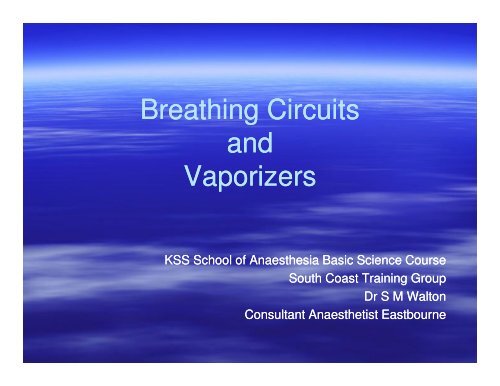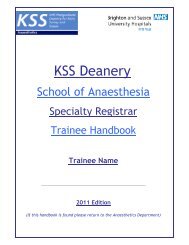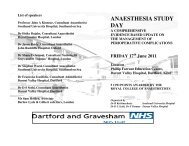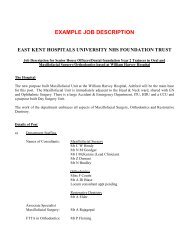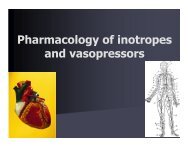Breathing Circuits and Vaporizers Breathing Circuits ... - KSS Deanery
Breathing Circuits and Vaporizers Breathing Circuits ... - KSS Deanery
Breathing Circuits and Vaporizers Breathing Circuits ... - KSS Deanery
Create successful ePaper yourself
Turn your PDF publications into a flip-book with our unique Google optimized e-Paper software.
<strong>Breathing</strong> <strong>Circuits</strong><br />
<strong>and</strong><br />
<strong>Vaporizers</strong><br />
<strong>KSS</strong> School of Anaesthesia Basic Science Course<br />
South Coast Training Group<br />
Dr S M Walton<br />
Consultant Anaesthetist Eastbourne
What you need to know<br />
<strong>Breathing</strong> <strong>Circuits</strong><br />
– Types/ Classification<br />
– Circle systems<br />
– Mapleson - ahhh<br />
Spontaneous/ Manual<br />
CO2 elimination<br />
FGF rates<br />
Vaporisers<br />
– Real circuits<br />
– Types/ Classification<br />
– Plenum vaporisers<br />
Basic principles of how they<br />
work<br />
Compensatory mechanisms<br />
– Newer vapor delivery units
<strong>Breathing</strong> <strong>Circuits</strong>
<strong>Breathing</strong> <strong>Circuits</strong><br />
Their purpose:<br />
– A delivery system for the anaesthetic<br />
– Maintain a supply of oxygen<br />
– Remove carbon dioxide from the body<br />
Without:<br />
– significantly increasing the work of breathing<br />
– significantly increasing physiological deadspace
Requirements for a breathing<br />
circuit?<br />
Essential<br />
– Deliver gases same<br />
conc as machine<br />
– Rapidly<br />
– Eliminate CO2<br />
– Minimal aparatus dead<br />
space<br />
– Minimal resistance<br />
Desirable<br />
– Economical<br />
– Conservation of heat<br />
– Humidification<br />
– Light weight<br />
– Easy to use<br />
– Polution<br />
– Adults + children<br />
– Efficient both spont <strong>and</strong><br />
mech.
Dead Space<br />
Anatomical<br />
Apparatus<br />
– Volume of breathing<br />
system<br />
– From patient end<br />
– To point to <strong>and</strong> fro<br />
movement takes place<br />
– ↑ leads to ↑PaCO2<br />
– The first portion contains no CO2 <strong>and</strong><br />
comes from the upper respiratory tract<br />
where no gas exchange takes place<br />
– This is the anatomical dead space
Rebreathing<br />
Expired alveolar gas (containing 5% carbon dioxide) is<br />
inspired as part of the next tidal volume<br />
Anaesthetic circuits are designed to minimize this occurring<br />
as it may lead to serious elevations in blood CO 2 levels:<br />
By<br />
– ensuring an adequate flow of fresh gas which flushes the circuit<br />
clear of alveolar gas,<br />
or<br />
– in the case of a circle system by the use of sodalime which absorbs<br />
the CO 2
Some Important Numbers<br />
<br />
MINUTE VENTILATION = TIDAL VOLUME x BREATHS/MIN.<br />
~80 mls/ kg/ min<br />
<br />
ALVEOLAR VENTILATION=(TIDAL VOLUME - DEAD SPACE) X<br />
BREATHS/MIN<br />
~70 mls/ kg/ min<br />
Fresh Gas Flow rates often set in relation to these numbers<br />
to prevent rebreathing.
Classifications<br />
§ Numerous classifications since anaesthesia<br />
began !!!<br />
1. Open, semi-open, semi-closed <strong>and</strong> closed<br />
2. Rebreathing <strong>and</strong> Non-rebreathing systems<br />
3. <strong>Breathing</strong> systems with CO2 absorption/ without CO2<br />
absorption<br />
4. Unidirectional flow/ bidirectional flow systems<br />
5. The Mapleson Classification
What we use in our practice:<br />
Semi-closed Systems<br />
Gas enters from machine<br />
Some leaves<br />
via scavenger<br />
Rest stays<br />
in circuit<br />
Two types:<br />
– Circle system (can be closed)<br />
– Mapleson Systems
Circle Systems<br />
Are great because:<br />
– Allow rebreathing of anaesthetic gases<br />
lower FGF rates - save money<br />
Less pollution<br />
Conserves heat <strong>and</strong> moisture<br />
– Minimal dead space
Components of the Circle System<br />
Fresh gas source<br />
Unidirectional valves<br />
Inspiratory & expiratory tubing<br />
Y-piece connector<br />
APL valve<br />
Reservoir bag<br />
CO 2 absorber<br />
VIC/ VOC
Rules for Circle System<br />
Unidirectional valve must be between patient & bag on<br />
both sides<br />
FGF cannot enter between patient & expiratory valve<br />
APL cannot be located between patient & inspiratory<br />
valve
What are the disadvantages?<br />
<br />
Slow changes in the<br />
inspired anaesthetic<br />
concentration<br />
– Inadequate delivery<br />
– Slow respond<br />
VOC only<br />
Closed systems unstable
Mapleson<br />
In 1954<br />
Mapleson W W. The elimination of rebreathing in various semi-closed anaesthetic systems. Brit. J.<br />
Anaesth. 26:323-32, 1954. [Department of Anaesthetics. Welsh National School of Medicine, Cardiff,<br />
Wales)<br />
Classified Semiclosed systems A-E depending on<br />
order of:<br />
– FGF entry, APL valve, Reservoir bag<br />
Adequate CO2 Removal depends on:<br />
– Circuit<br />
– FGF<br />
– Spontaneous/ Manual
Mapleson<br />
Layout simple<br />
What happens to CO2 very complex
Mapleson A<br />
<br />
<br />
The expiratory valve close to the<br />
patient to reduce the dead space.<br />
Afferent reservoir system<br />
High FGF flushes tubing between breaths<br />
<br />
<br />
Spont Ventilation<br />
FGF = Minute Volume<br />
~6 l min-1<br />
Good<br />
Manual Ventilation<br />
FGF = 2.5 x Minute Volume<br />
Bad<br />
~15 l min-1<br />
Magill<br />
Lack
Real <strong>Circuits</strong><br />
Lack
Mapleson B <strong>and</strong> C<br />
Not commonly used in anaesthetic practice<br />
Mapleson C used in ITU<br />
‘Waters circuit’<br />
Need high FGF
Mapleson D<br />
Mechanical Ventilation<br />
Fresh Gas fills distal part of<br />
corrugated tube<br />
<br />
<br />
<br />
<br />
<br />
<br />
FGF delivered to the patient end<br />
APL valves + breathing bag at the<br />
expiratory end of the circuit<br />
Efferent reservoir system<br />
Spontaneous ventilation<br />
FGF = 2.5 x Minute Volume<br />
Bad<br />
~15l min-1<br />
Manual Vent<br />
FGF = Minute Volume<br />
Good<br />
Inner tube leak dangerous
The Bain Circuit<br />
Bain system<br />
–Bain JA, Spoerel WE. A streamlined anaesthetic system. Can Anaesth Soc J 1972; 19: 426-35
Mapleson E <strong>and</strong> “F”<br />
<br />
<br />
<br />
<br />
<br />
Used in Paediatrics<br />
Performs in a similar way to<br />
the Mapleson D<br />
No valves = little resistance to<br />
breathing<br />
Introduced in 1937 by P Ayre <strong>and</strong><br />
is known as the Ayre's T-piece<br />
Jackson-Rees modification which<br />
has an open bag attached to the<br />
expiratory limb<br />
<br />
Spont Vent FGF = 3 x Minute<br />
Volume<br />
Manual Vent FGF = 1000 +<br />
100 mls/kg
Humphrey ADE<br />
Not really just A, D, E combined<br />
More efficient ~ 50mls/kg/min<br />
Use on paediatrics
Humphrey ADE
Vaporisers
Eagle Bill`s Vaporizing Pipe<br />
Customer reviews of this product<br />
"Like no other vaporiser you've ever used!!..."<br />
Tom W, 2008-09-06 19:30:15
DEFINITIONS<br />
Vapour<br />
– Matter in the gaseous form below its critical temperature<br />
Latent heat of vaporisation<br />
– Amount of heat required to vaporise a particular liquid<br />
Vapour Pressure<br />
– Pressure exerted by molecules escaping from the<br />
surface of the liquid to enter gaseous state
DEFINITIONS<br />
Saturated Vapour Pressure<br />
– Equilibrium point at which no. of molecules<br />
leaving liquid state is equal to no. entering<br />
Boiling Point<br />
– Temperature at which vapour pressure is equal<br />
to atmospheric pressure
Properties of commonly used<br />
agents<br />
Volatile<br />
agent<br />
SVP(kPa<br />
) at 20°C<br />
BP (°C) at<br />
100kPa<br />
MAC<br />
Halothane 31.9 51 0.76<br />
Enflurane 23.1 56 1.68<br />
Isoflurane 31.5 48 1.15<br />
Sevoflurane 21.3 58 2<br />
Desflurane 88.5 23 6
FUNCTIONS OF VAPORISERS<br />
- Produce vaporisation of volatile agent<br />
- Mix vapour with fresh gas flow<br />
- Control the mixture despite variables<br />
i.e,<br />
to deliver safe <strong>and</strong> accurate concentrations<br />
of inhalational anaesthetic agents to the<br />
patient
Classification of Vaporisers<br />
Simple<br />
Variable Bypass<br />
– Draw Over<br />
– Plenum<br />
Measured Flow Vaporisers<br />
Aladin Cassettes
Simple<br />
vaporising chamber - metal/ glass bowl or bottle<br />
containing liquid anaesthetic<br />
tap controlling the proportion of gas flowing through<br />
it
VARIABLE BYPASS<br />
VAPORISER<br />
Fresh gas flow split into two streams by a flow splitting<br />
valve<br />
One stream bypasses the vaporising chamber, other<br />
passes through <strong>and</strong> becomes saturated<br />
Streams then re-join<br />
Final concentration determined by use of flow splitting<br />
valve<br />
2 main types – Plenum <strong>and</strong> Draw over
DRAW OVER VAPORISERS<br />
Gas is drawn into the vaporising chamber by patient’s<br />
inspired effort<br />
Low resistance<br />
Used within circuit<br />
– a circle absorber system<br />
– non-rebreathing draw-over apparatus<br />
Don’t require pressurised source of gases<br />
Useful for field hospitals<br />
– Battle fields <strong>and</strong> bush<br />
Poor accuracy of concentrations
Examples include<br />
– Epstein Mackintosh Oxford (EMO),<br />
– Oxford Miniature Vaporiser (OMV)<br />
– Tri-service apparatus
PLENUM VAPORISERS<br />
Most commonly used in<br />
modern hospital practice<br />
Precision Vaporisers<br />
Gas passes through vaporiser<br />
under pressure at the back bar<br />
of the machine<br />
High resistance<br />
Examples include Ohmeda<br />
TEC 3/4/5/,
Why are they precision?<br />
FACTORS AFFECTING PRECISION<br />
– Fresh gas flow – as flow rate increases, increasing amount of vapour is<br />
required to saturate the carrier gas<br />
– Anaesthetic potency –More potent volatile agents require greater dilution<br />
of the vapour <strong>and</strong> the greater the splitting ratio<br />
– SVP – Agents with a higher SVP are easier to vaporise <strong>and</strong> require higher<br />
ratios<br />
– Pumping effect – Effect produced by repetitive changes in circuit<br />
resistance at common gas outlet. Can lead to surges of volatile<br />
agent in circuit
FACTORS AFFECTING<br />
PRECISION<br />
Temperature<br />
– Increasing environmental temperature causes an<br />
increase in SVP.<br />
– Temperature tends to fall in chamber due to latent heat<br />
of vaporisation, which is more marked at higher flows
Why are they precision?<br />
BECAUSE OF COMPENSATORY MECHANISMS<br />
– Plenum vaporisers are incredibly efficient<br />
Drager 19
COMPENSATORY MECHANISMS<br />
1. Use of wicks <strong>and</strong> bubble mechanisms to increase<br />
surface area
COMPENSATORY MECHANISMS<br />
2. Bimetallic strip<br />
varies flow through bypass chamber with temperature<br />
change<br />
3. Heat sinks<br />
metal or water at base of vaporiser to smooth out<br />
temperature fluctuations
MEASURED FLOW<br />
VAPORISER<br />
Used for Desflurane (TEC 6)<br />
Boiling point of Desflurane is 23.6°C<br />
Chamber in which volatile agent is heated by electrical<br />
element to 39°C<br />
– Need plugging in <strong>and</strong> warm up<br />
Produces pure vapour under pressure<br />
Controls addition of the pressurised vapour to the fresh gas<br />
flow using pressure compensated controlled valve
Datex-Ohmeda Aladin vaporizer<br />
Cassettes containing volatile liquid anesthetic<br />
Inserted into a port containing the central electronic control<br />
mechanism<br />
This dispenses agent into the stream of fresh gas flow.<br />
Controlled by a throttle valve steered by the central<br />
processing unit (CPU).<br />
Cassette is only a liquid sump without control<br />
mechanisms<br />
They can be tipped in any orientation<br />
without danger<br />
Maintenance free
How do you use a vaporiser at<br />
altitude?<br />
Atmospheric pressure decreases<br />
But SVP pressure stays the same<br />
Should you turn down your vaporiser?<br />
No<br />
Vaporisers aren’t calibrated for atm pressure
Because it’s the partial pressure that matters<br />
not the concentration dialed up<br />
Imagine gas X has MAC of 10%<br />
<br />
This actually means you need Partial pressure<br />
of 10kpa in alveolus<br />
<br />
at atmospheric pressure (100kpa)<br />
SVP is 20%<br />
Splitting ratio of 1:1<br />
<br />
<br />
<br />
<br />
Go to 6000m - SVP stays the same (related to<br />
temperature) but atm pressure halves<br />
Splitting ratio same<br />
This will double the concentration given by<br />
vaporiser 20%<br />
But this delivers the same partial pressure of<br />
(20% of 50 kpa = )10kpa
Questions?


